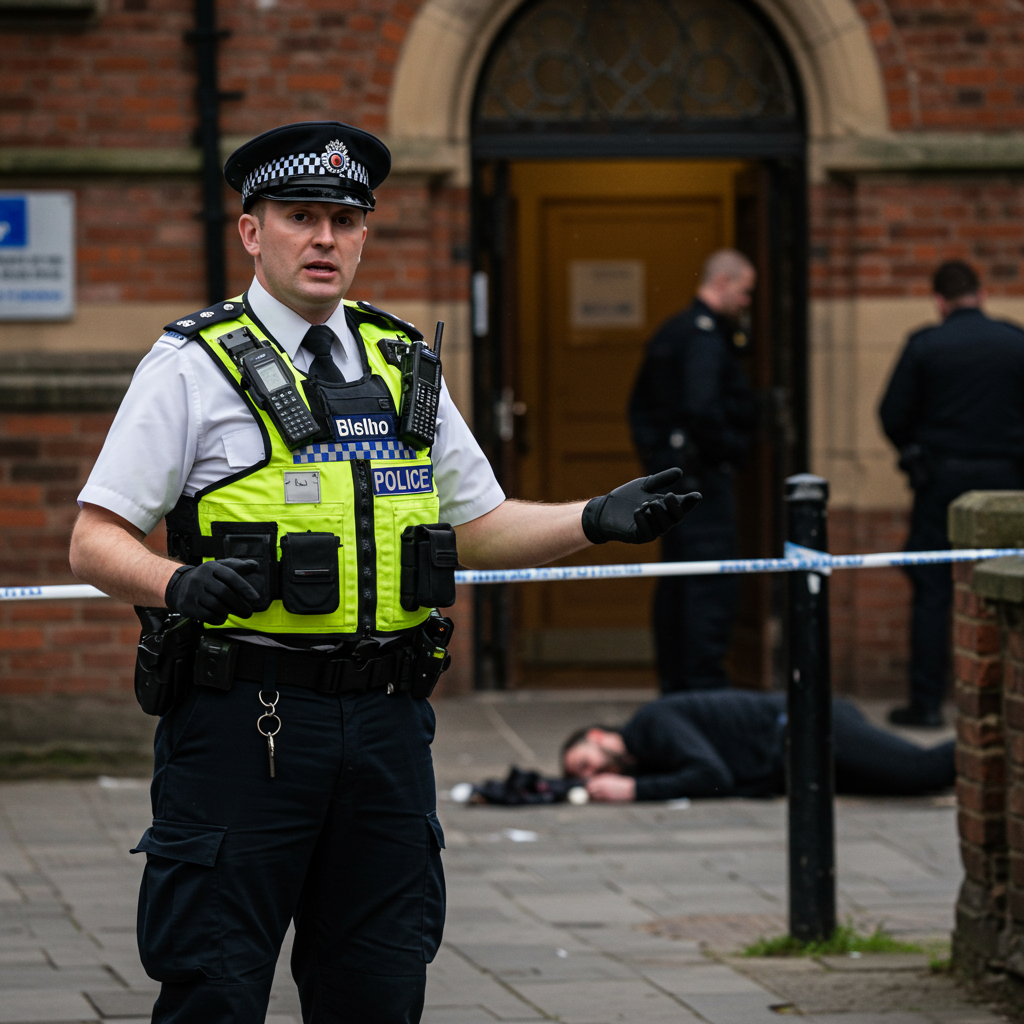A tragic incident at a Manchester synagogue, where a terror attack on Yom Kippur claimed two lives, has taken a shocking turn. Police in Greater Manchester have revealed that one of the victims, identified as Adrian Daulby, may have died from a gunshot fired by an officer responding to the chaotic scene. This unforeseen consequence highlights the immense pressures faced by law enforcement during rapidly unfolding terror events. The revelation has sent shockwaves through the community, already grieving the loss of two Jewish men and grappling with rising antisemitism.
Unfolding Horror: A Yom Kippur Attack
On October 3, 2025, the holiest day in the Jewish calendar, Yom Kippur, became a day of terror for Manchester’s Jewish community. A violent attack unfolded outside the Heaton Park Hebrew Congregation synagogue in Crumpsall, Manchester. The assailant, later identified as 35-year-old Jihad Al Shamie, a British citizen of Syrian descent, launched a multi-pronged assault.
At approximately 9:30 a.m. local time, Al Shamie drove a vehicle directly into people gathered outside the synagogue. Following this vehicular assault, he exited the car, armed with a knife, and began attacking individuals. Worshippers inside the synagogue bravely blockaded the doors, successfully preventing the attacker from gaining entry to the building, which was filled with congregants. Police were called to the scene by a member of the public reporting a car being driven at people.
The attack tragically claimed the lives of two local Jewish residents: Adrian Daulby, 53, and Melvin Cravitz, 66. Three other individuals sustained serious injuries and were hospitalized. Police officers arrived swiftly and confronted Al Shamie, who was wearing a vest that appeared to contain explosives. These were later confirmed to be non-viable. Officers shot and killed Al Shamie within minutes of the attack beginning.
The Tragic Revelation: Police Gunfire Investigated
Just a day after the horrific Manchester synagogue attack, Greater Manchester Police (GMP) made a significant and sobering announcement. Chief Constable Stephen Watson confirmed that a government pathologist provisionally determined one of the deceased victims, Adrian Daulby, had sustained a wound consistent with a gunshot injury. This finding suggested a devastating possibility: the fatal shot might have come from police.
Chief Constable Watson explicitly stated that the suspect, Jihad Al Shamie, was not in possession of a firearm during the attack. “It follows therefore,” Watson explained, “that subject to further forensic examination, this injury may sadly have been sustained as a tragic and unforeseen consequence of the urgently required action taken by my officers to bring this vicious attack to an end.”
Further adding to the complexity, medical professionals advised police that one of the three victims currently receiving hospital treatment also suffered a gunshot wound. Mercifully, this injury is not life-threatening. The chief constable emphasized that police officers were the only individuals who fired shots during the incident. They acted to prevent Al Shamie from entering the synagogue and causing further harm. This candid acknowledgment by the GMP underscores the perilous nature of counter-terrorism operations, where split-second decisions in chaotic environments can lead to devastating unintended outcomes.
Law Enforcement’s Swift, Complex Response
The response to the Manchester terror attack was immediate and decisive, yet fraught with immense challenges. Police officers arrived at the Heaton Park Hebrew Congregation synagogue within minutes of the initial reports. Their primary objective was to neutralize the active threat and protect the large number of worshippers inside. The attacker, Jihad Al Shamie, was quickly confronted and shot dead. The entire engagement, from the first reports to the neutralization of the suspect, reportedly took just seven to ten minutes.
This rapid intervention, while effective in preventing greater loss of life inside the synagogue, inadvertently led to the tragic friendly fire incident. Police stated that the victims struck by police gunfire were believed to have been “close together” behind the synagogue door, attempting to prevent the attacker from entering. This detail paints a harrowing picture of bravery and chaos intertwining. The immediate disclosure of this potential circumstance by GMP reflects a commitment to transparency, even amidst ongoing investigations into law enforcement actions and protocols during terror attacks.
Community Impact and Political Condemnation
The Manchester synagogue attack plunged the local community into deep shock and grief. The incident, occurring on Yom Kippur, amplified its devastating impact. Local Jewish leaders and members expressed profound sorrow and renewed fears for their safety. The attack was widely condemned across the UK political spectrum, with leaders unifying in their condemnation of antisemitic violence.
U.K. Prime Minister Sir Keir Starmer, accompanied by Lady Victoria Starmer, visited the scene the day after the attack. He spoke with police and other officials outside the synagogue, offering solidarity and reassurance. In a powerful social media post, Starmer declared the attack “a vile terrorist attack that attacked Jews, because they are Jews.” He stressed, “Antisemitism is a hatred that is rising, once again. Britain must defeat it, once again.” He pledged to utilize every power available to guarantee the security of Jewish communities.
Chief Rabbi Ephraim Mirvis, the head of Orthodox Judaism in Britain, also weighed in, describing the attack as a consequence of an “unrelenting wave of Jew hatred.” He urged authorities to “get a grip on these demonstrations” that he believes lead to such violence, highlighting the sensitive and often contentious link between geopolitical events and domestic antisemitism.
Ongoing Investigation and Wider Implications
The investigation into the Manchester synagogue attack is extensive and continues near the synagogue in Crumpsall. Beyond neutralizing the immediate threat, police have arrested three other individuals in connection with the attack: two men in their 30s and a woman in her 60s. They face charges of commission, preparation, and instigation of acts of terrorism, suggesting a broader inquiry into potential accomplices or connections.
Home Secretary Shabana Mahmood confirmed that Jihad Al Shamie was not previously known to police or to Prevent, the national counter-terrorism program. This raises critical questions about how individuals become radicalized and the intelligence challenges in identifying lone actors. The motive for Al Shamie’s attack remains under investigation.
The incident is set against a concerning backdrop of rising antisemitic incidents in the U.K. Data indicates that the first half of the year saw more than 1,500 antisemitic incidents reported by the Community Security Trust, marking the second-highest six-month total on record. This surge is significantly linked to the Hamas attack on Israel on October 7, 2023, and the subsequent conflict in Gaza. The attack has also ignited debates around freedom of protest and the language used in demonstrations, with some linking certain pro-Palestinian chants to inciting violence. Even Al Shamie’s family publicly condemned the “heinous act,” expressing shock and sorrow and distancing themselves from the attack. This underscores the complex layers of communal and national grief.
Frequently Asked Questions
What new information has emerged about the Manchester synagogue attack?
A crucial new detail is the provisional determination by a government pathologist that Adrian Daulby, one of the two victims killed in the attack, sustained a wound consistent with a gunshot injury. Given that the attacker, Jihad Al Shamie, was not armed with a firearm, police believe this fatal shot, along with a non-life-threatening injury to another victim, may have been fired by responding police officers in the chaotic effort to stop the assault.
Who were the victims and the attacker in the Manchester terror incident?
The two Jewish men tragically killed in the attack were Adrian Daulby, 53, and Melvin Cravitz, 66, both local residents. The attacker was identified as Jihad Al Shamie, a 35-year-old British citizen of Syrian descent. He was shot and killed by police officers at the scene after initiating a vehicle and stabbing attack outside the Heaton Park Hebrew Congregation synagogue.
How has the Manchester synagogue attack impacted discussions around antisemitism in the UK?
The attack has intensified concerns about rising antisemitism in the UK, particularly in the wake of the October 7, 2023, events in Israel. Political leaders, including Prime Minister Keir Starmer and Chief Rabbi Ephraim Mirvis, strongly condemned the attack as religiously motivated. Recent data from the Community Security Trust reports a significant increase in antisemitic incidents, highlighting an urgent need for enhanced security measures and a national effort to combat hatred against the Jewish community.
A Call for Vigilance and Solidarity
The Manchester synagogue attack stands as a stark reminder of the persistent threat of terrorism and the critical importance of community resilience. The tragic revelation regarding the police gunfire adds a profound layer of complexity and sorrow to an already devastating event. As investigations continue and the community grapples with this multifaceted tragedy, the focus remains on supporting the victims, ensuring justice, and confronting the rising tide of antisemitism. This incident underscores the urgent need for continued vigilance, robust security measures, and unwavering solidarity with all communities targeted by hatred.


